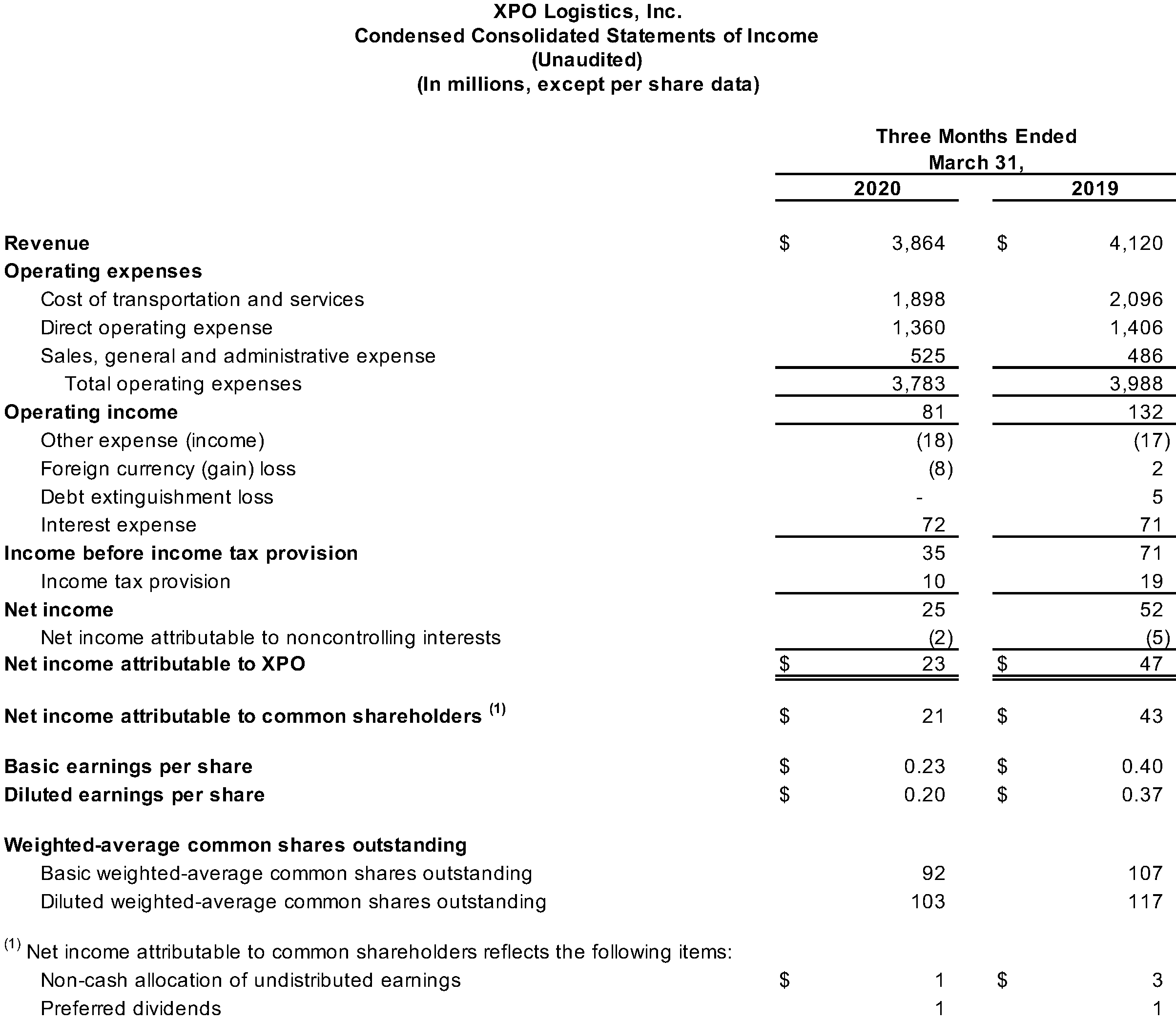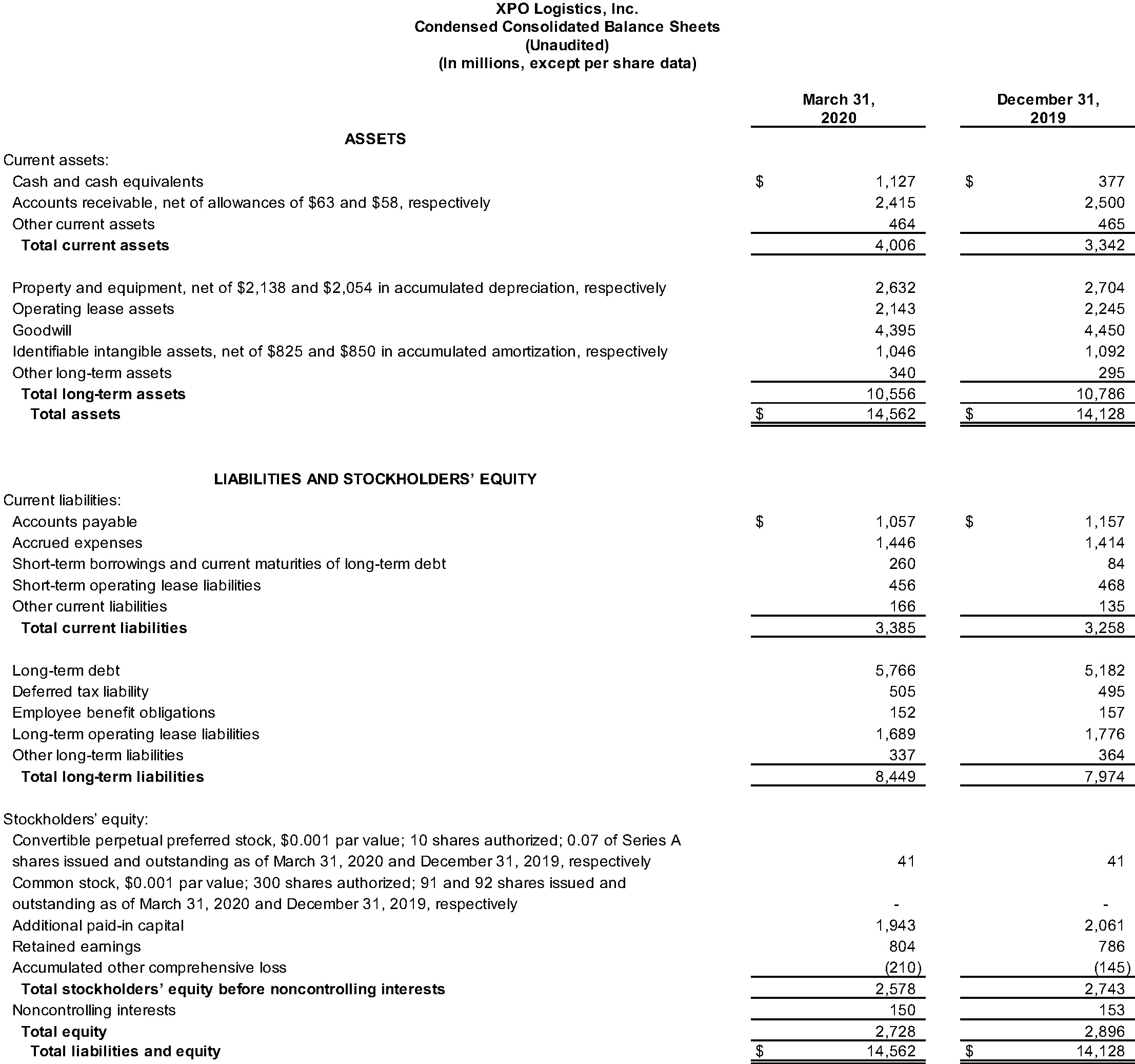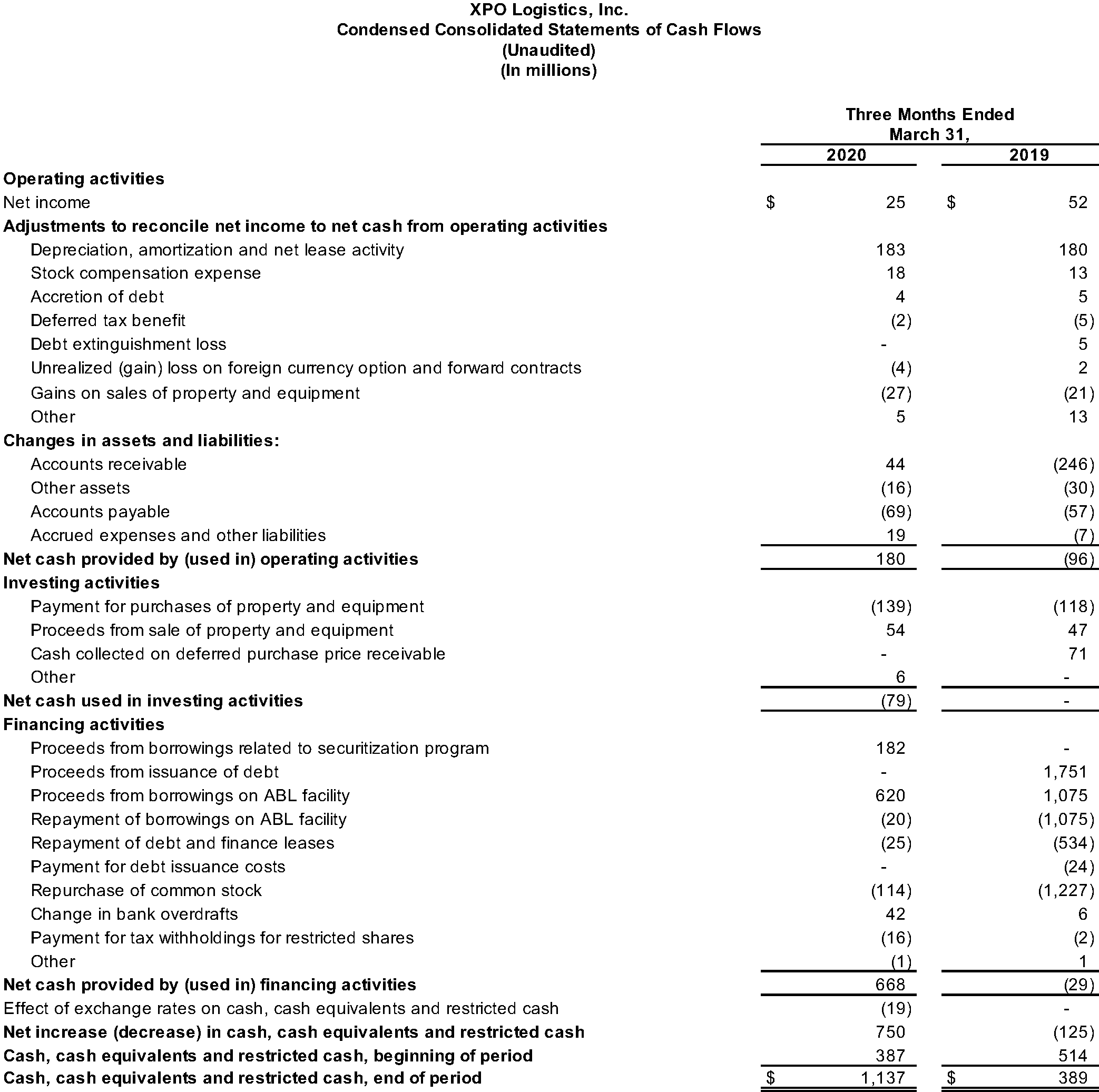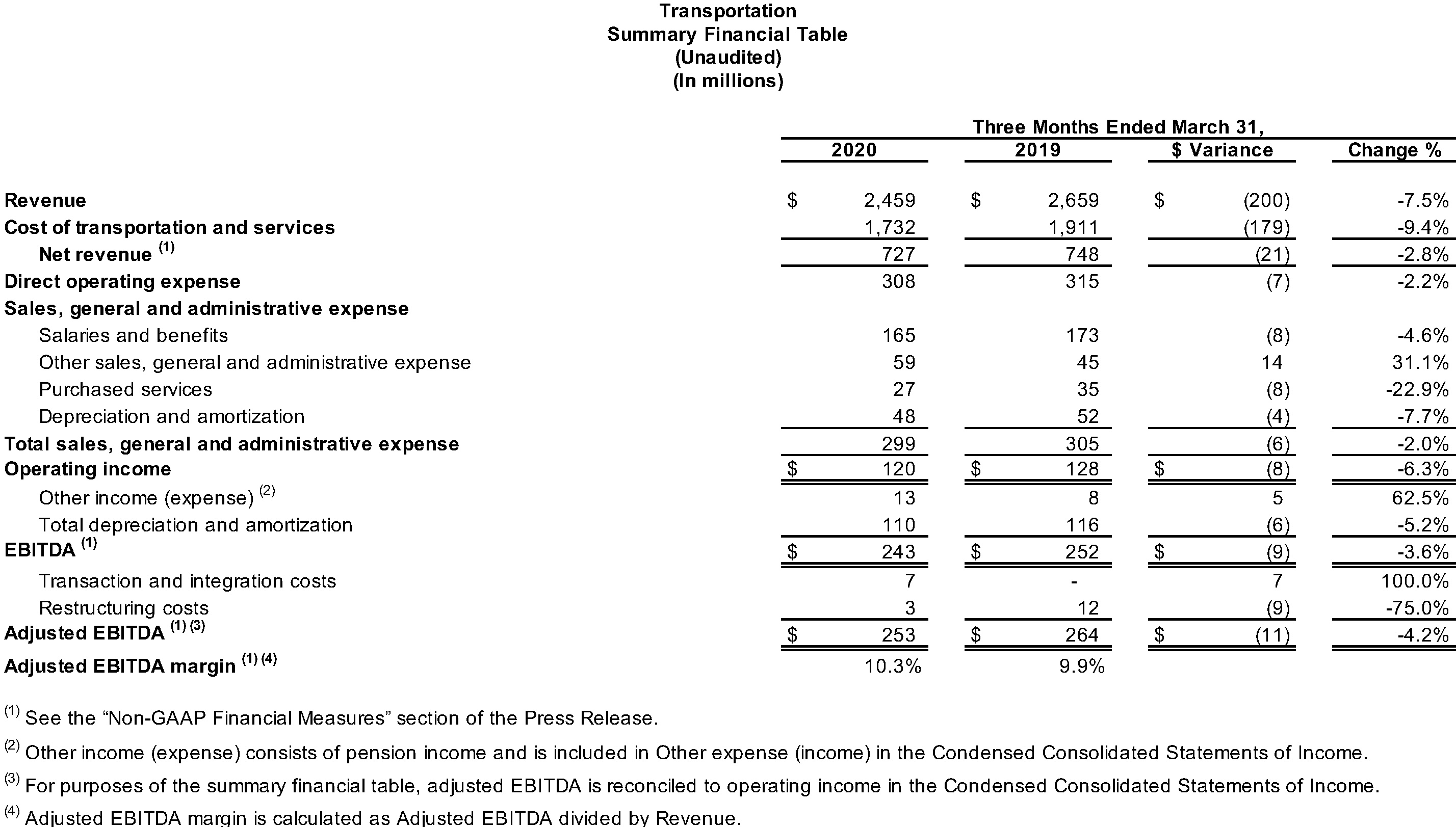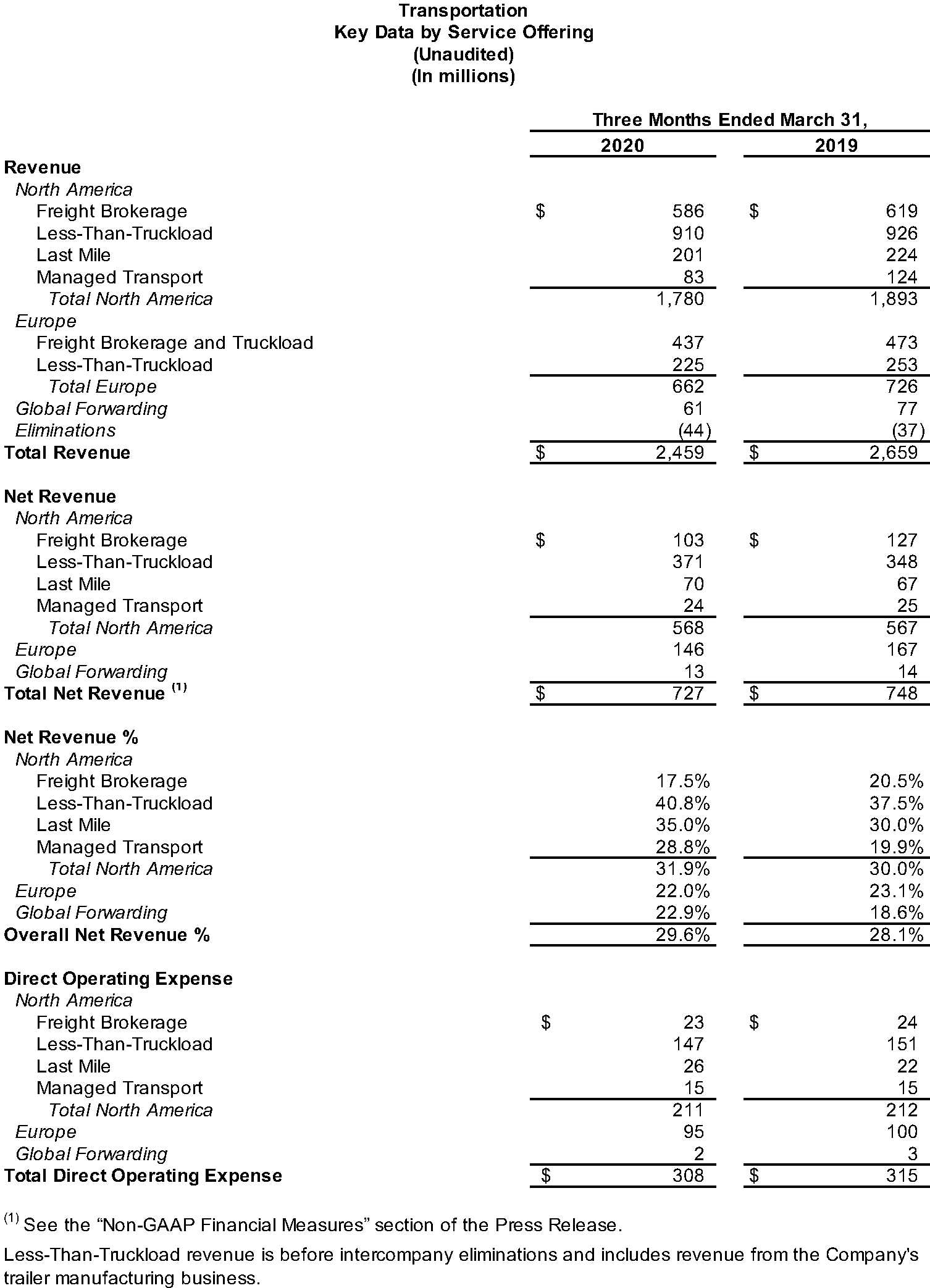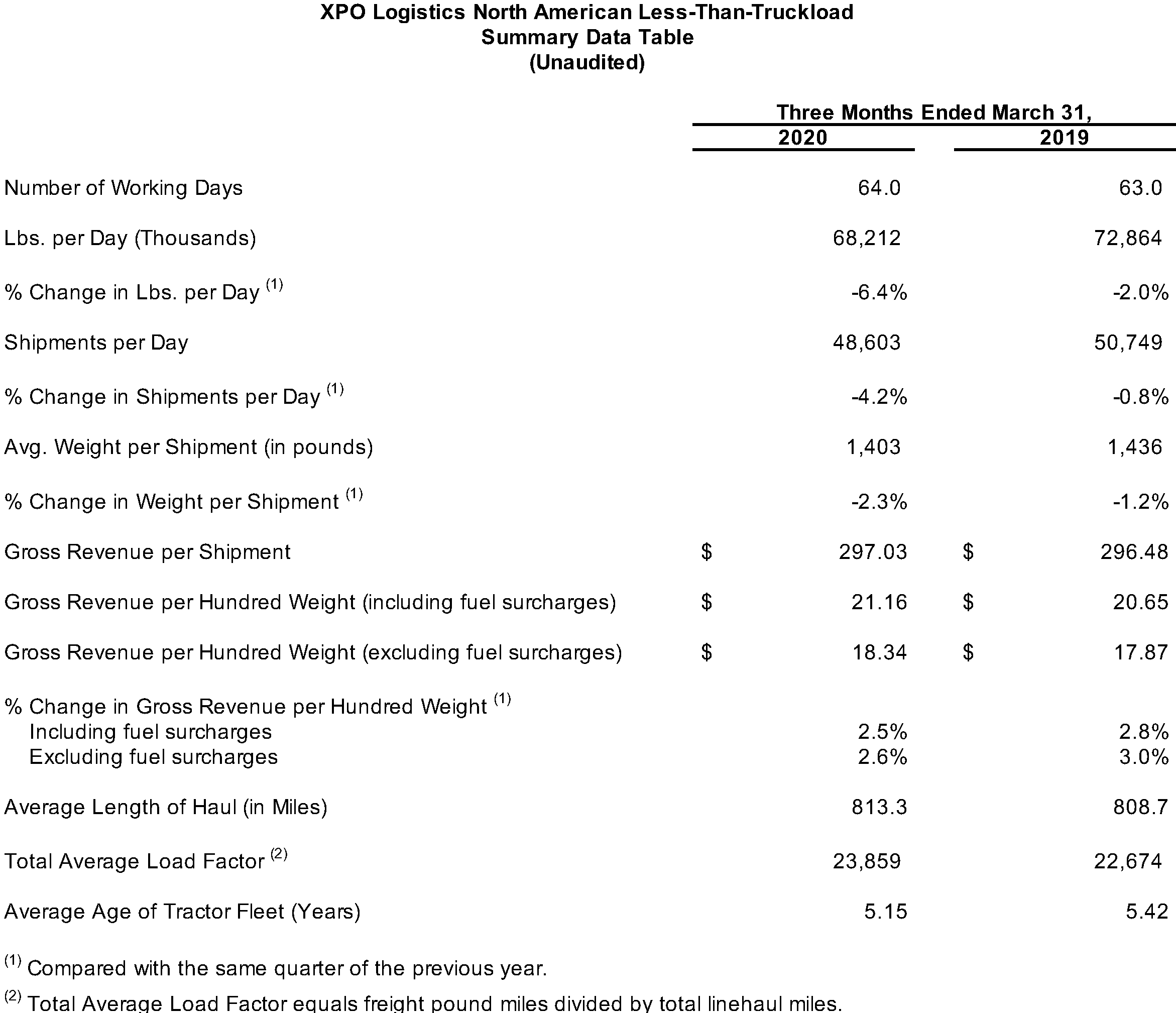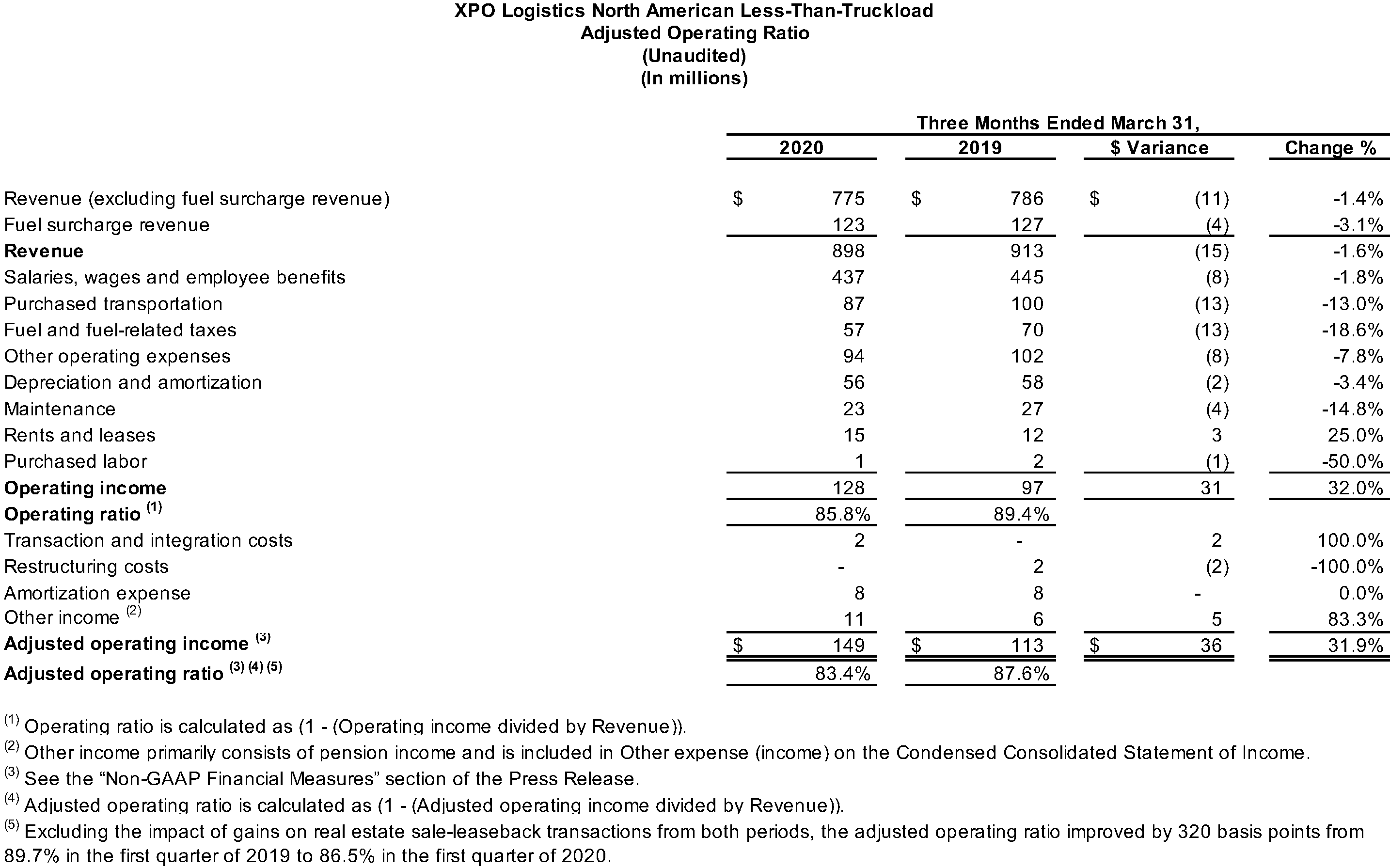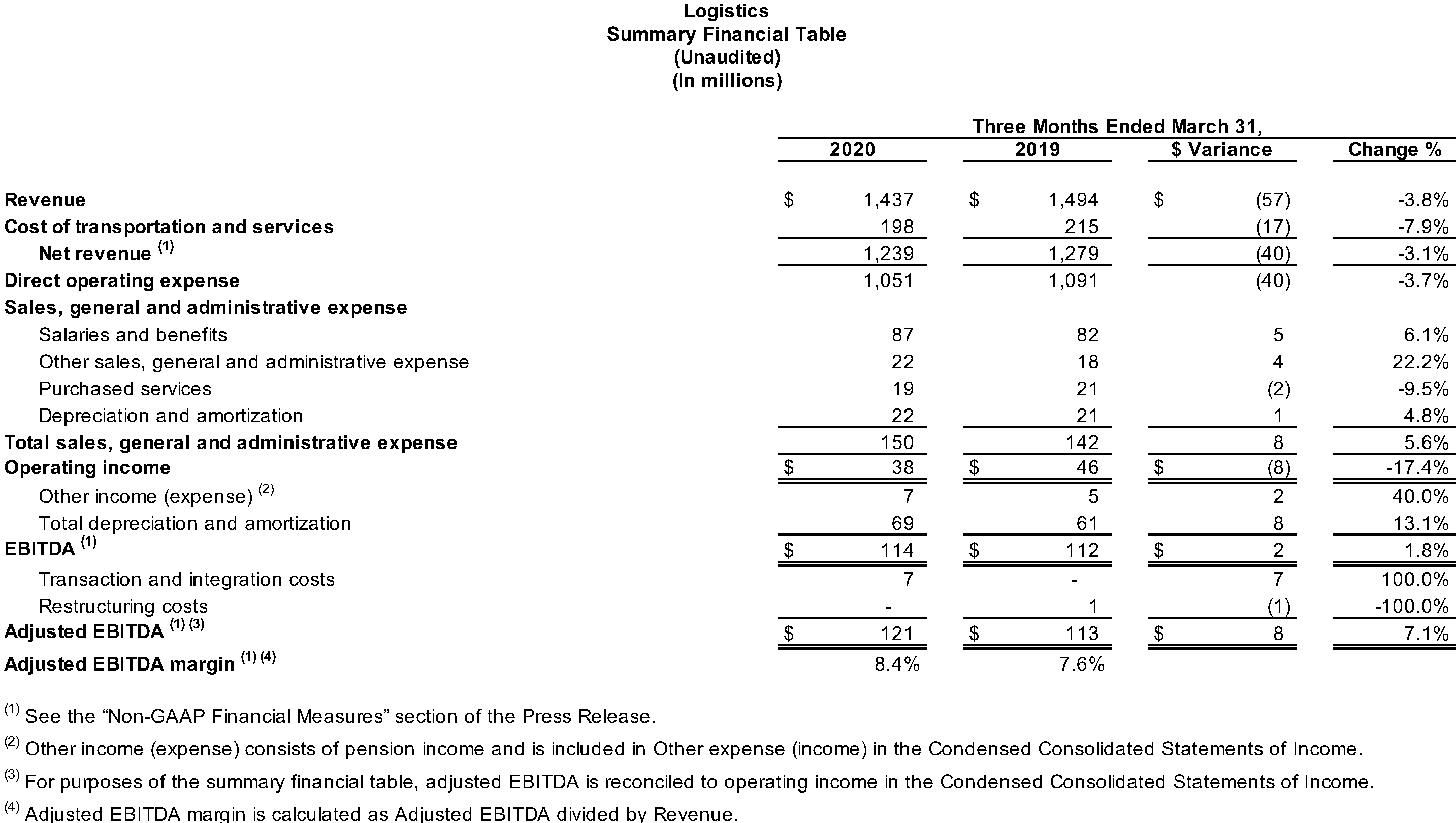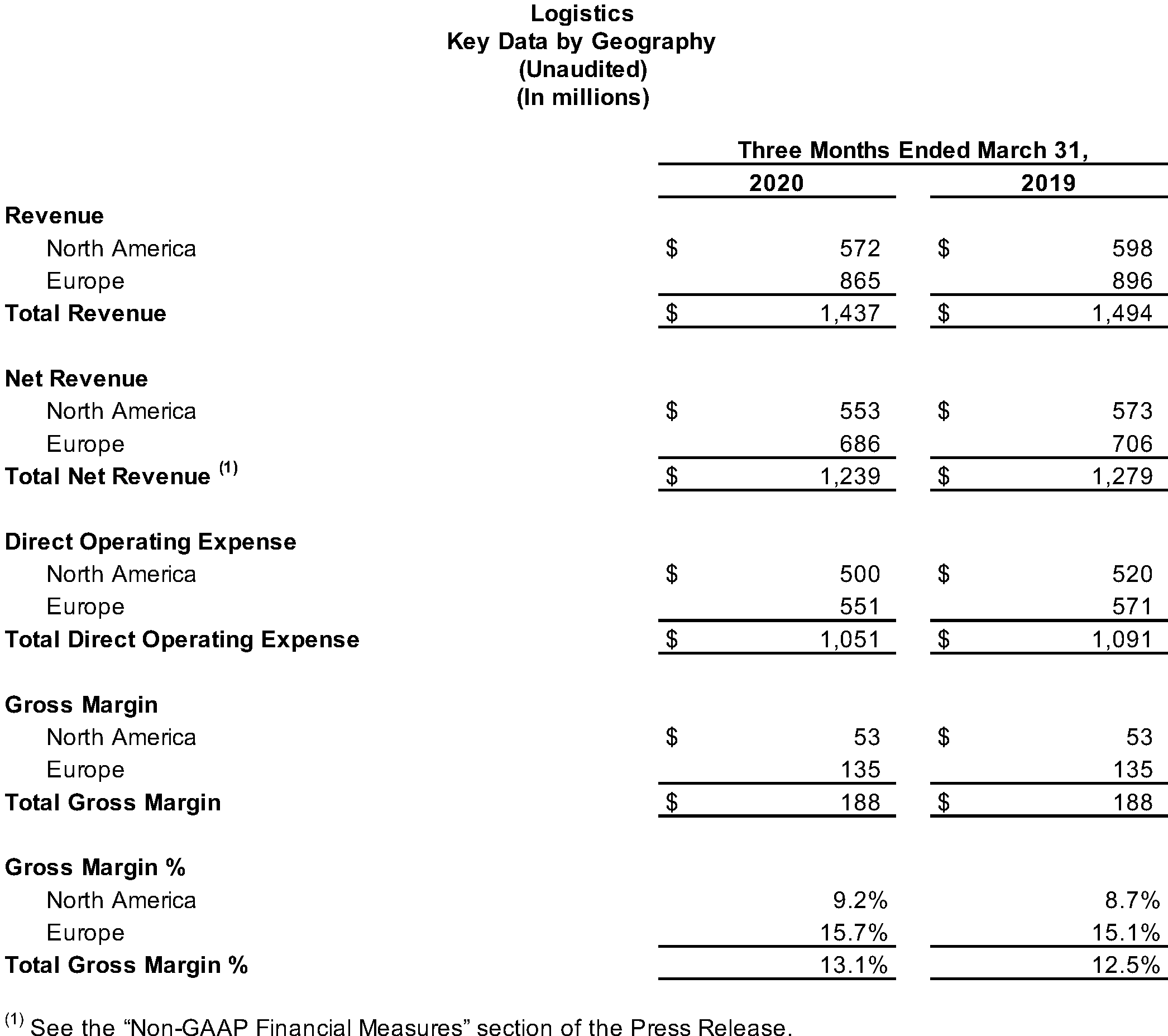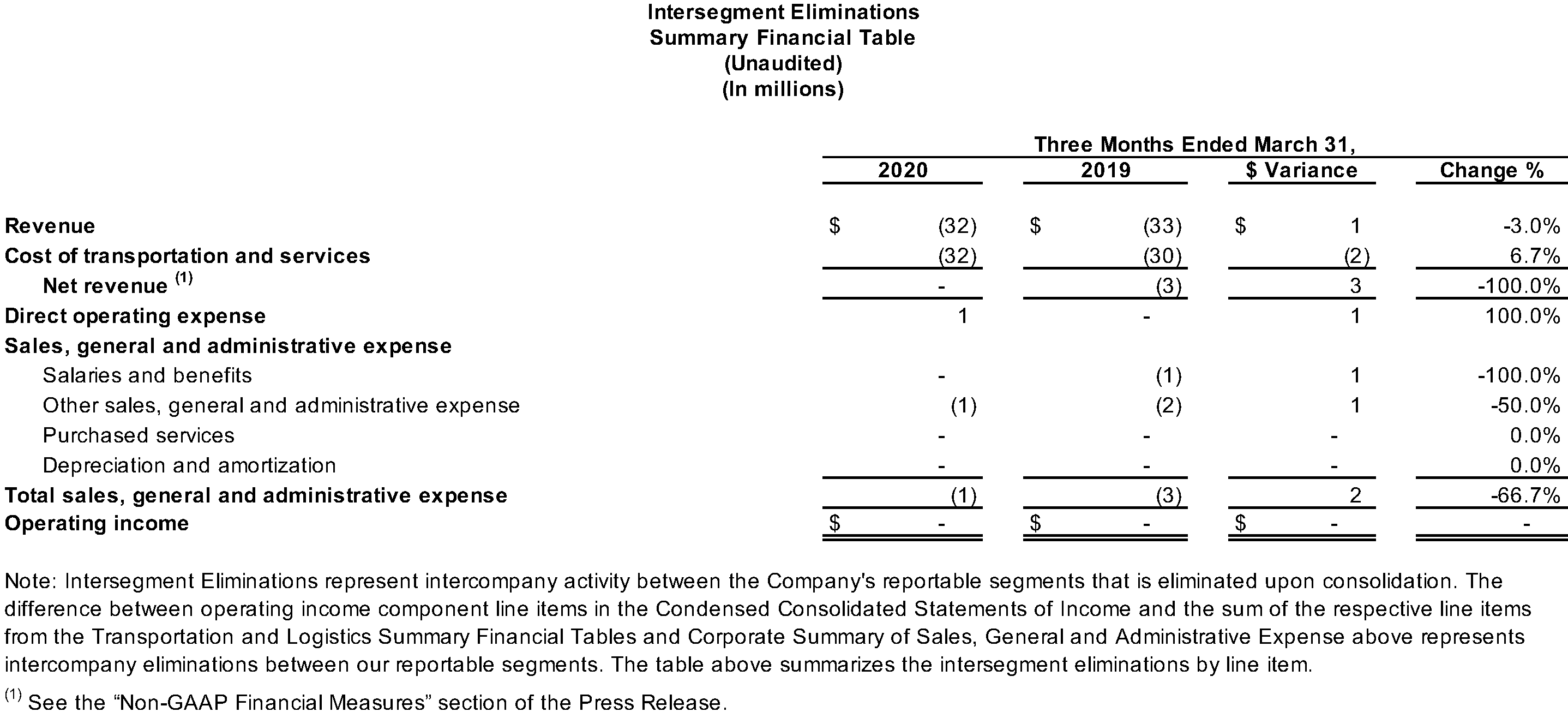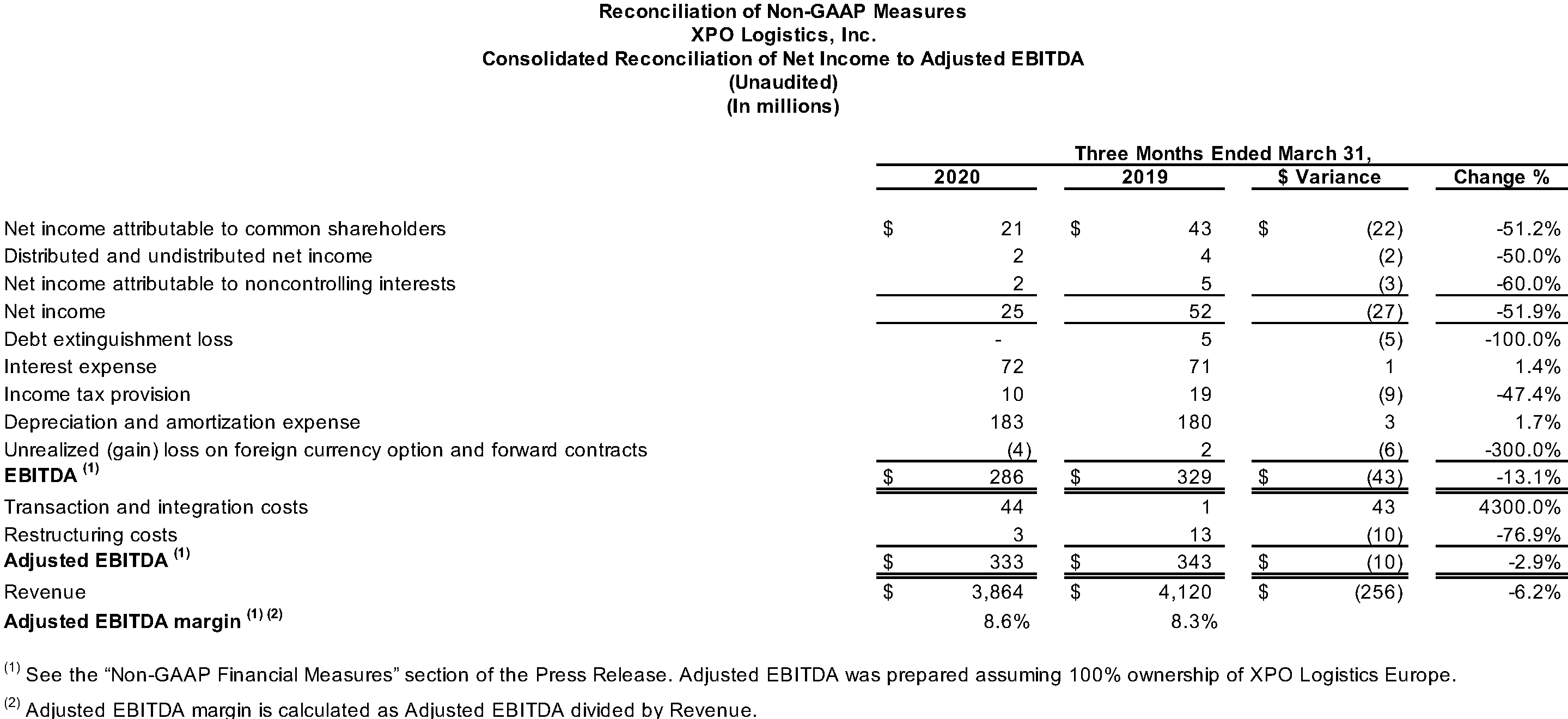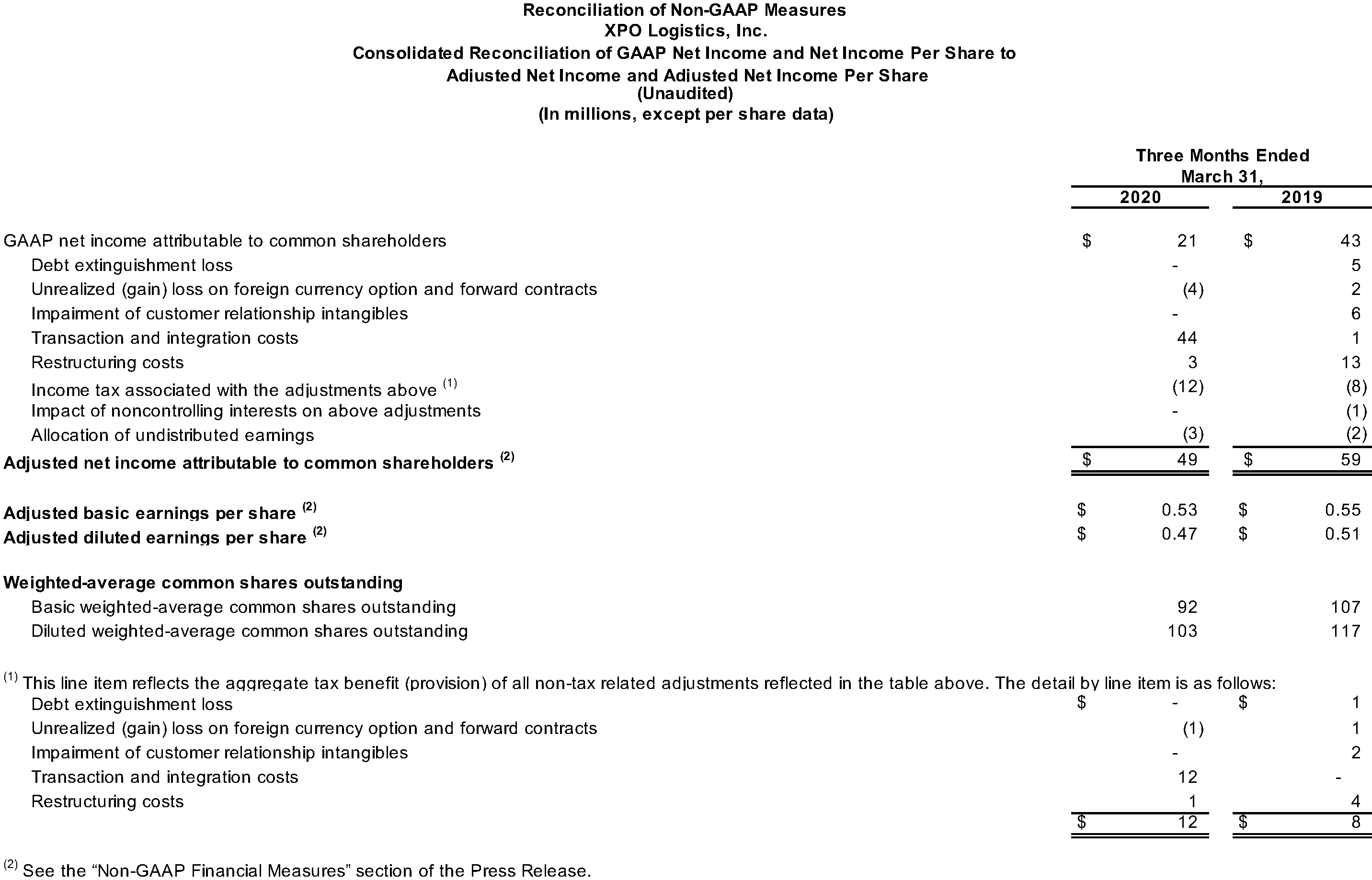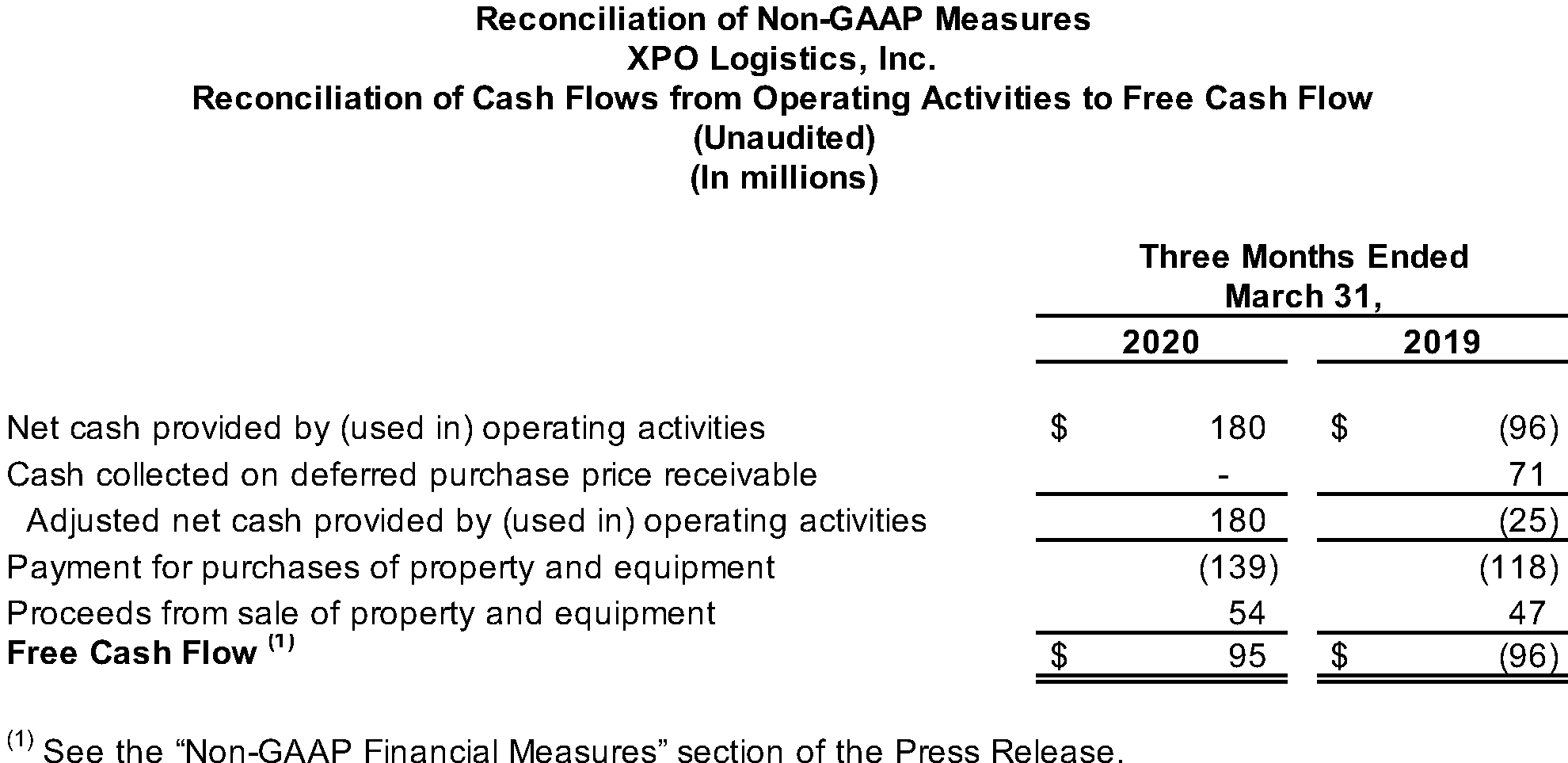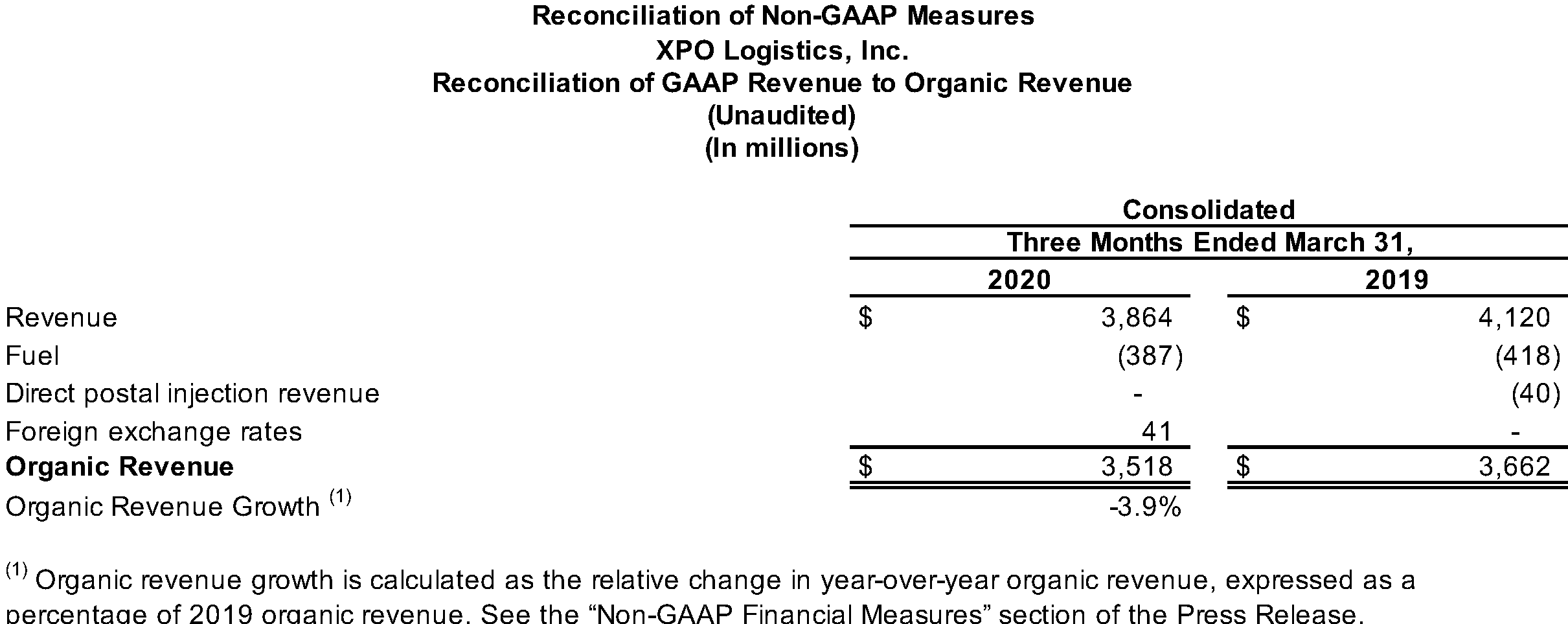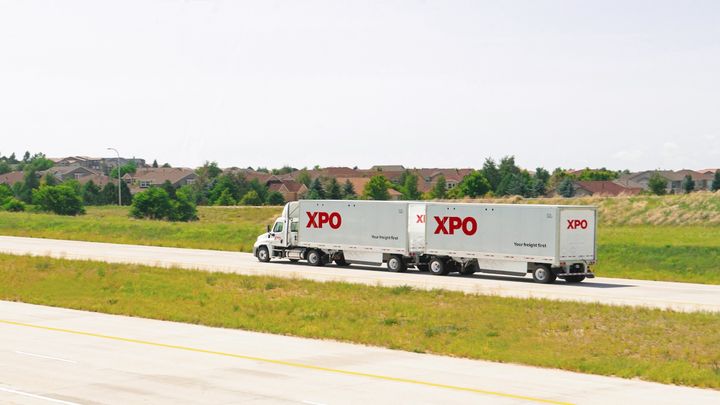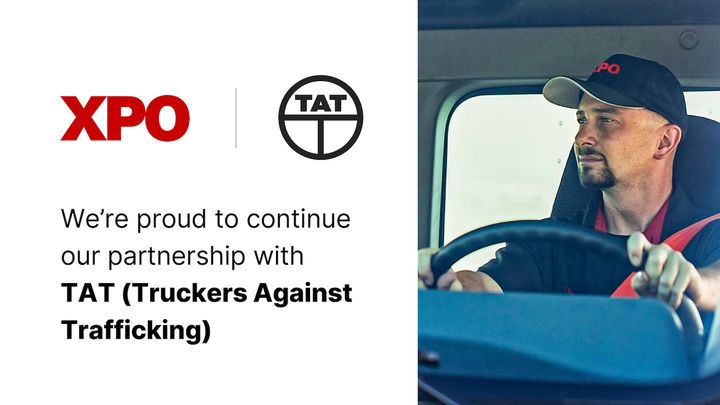XPO Logistics Announces First Quarter 2020 Results
XPO Logistics, Inc. (NYSE: XPO) today announced financial results for the first quarter 2020. Revenue was $3.86 billion for the quarter, compared with $4.12 billion for the same period in 2019. Net income attributable to common shareholders was $21 million for the quarter, compared with $43 million for the same period in 2019. Operating income was $81 million for the quarter, compared with $132 million for the same period in 2019. Diluted earnings per share was $0.20 for the quarter, compared with $0.37 for the same period in 2019.
Adjusted net income attributable to common shareholders, a non-GAAP financial measure, was $49 million for the first quarter 2020, compared with $59 million for the same period in 2019. Adjusted diluted earnings per share, a non-GAAP financial measure, was $0.47 for the quarter, compared with $0.51 for the same period in 2019.
Adjusted earnings before interest, taxes, depreciation and amortization ("adjusted EBITDA"), a non-GAAP financial measure, was $333 million for the first quarter 2020, compared with $343 million for the same period in 2019. Adjusted EBITDA for the first quarter 2020 excludes $47 million of transaction, integration and restructuring costs, primarily related to the company’s terminated review of strategic alternatives.
For the first three months of 2020, the company generated $180 million of cash flow from operations, compared with a cash usage of $96 million for the same period in 2019. For the first three months of 2020, the company generated $95 million of free cash flow, a non-GAAP measure, compared with a cash usage of $96 million for the same period in 2019. Reconciliations of non-GAAP financial measures used in this release are provided in the attached financial tables.
CEO Comments
Brad Jacobs, chairman and chief executive officer of XPO Logistics, said, “Our results were tracking well until mid-March, when COVID-19 reached pandemic proportions. At that point, our end markets rapidly deteriorated. We acted quickly and took comprehensive safety measures to protect our employees on the front line. I’m immensely grateful to our team for stepping up to the challenge of providing essential supply chain services in this environment.”
Jacobs continued, “Importantly, XPO has $2.5 billion of liquidity and an ironclad business model. Even against the current backdrop, we’re on track to generate hundreds of millions of dollars of free cash flow this year. We’re ready to serve customers through the fits and starts of the recovery, however long it takes, with our e-commerce capabilities, intelligent automation in our warehouses, a digitally connected transportation platform and keen visibility into operating data.”
Liquidity
As of March 31, 2020, XPO had total cash and borrowing capacity of $1.3 billion. In April, the company issued $850 million of 6.25% senior notes maturing in 2025 and added a new $350 million senior secured credit facility. Pro forma for the April financing activities, the company’s total liquidity increased to $2.5 billion, including $2.0 billion of cash, as of March 31, 2020. XPO has no significant debt maturing until June 2022.
2020 Guidance
The company withdrew its full-year 2020 guidance on April 23, 2020 in light of the COVID-19 pandemic.
First Quarter 2020 Results by Segment
- Transportation: The company's transportation segment generated revenue of $2.46 billion for the first quarter 2020, compared with $2.66 billion for the same period in 2019. The decrease in revenue primarily reflects the negative impact of COVID-19 and the previously disclosed downsizing of business by the company’s largest customer.
Operating income for the transportation segment was $120 million for the first quarter 2020, compared with $128 million for the same period in 2019. The decrease in operating income is primarily related to the decrease in segment revenue and to higher transaction and integration expenses. Adjusted EBITDA for the segment was $253 million for the quarter, compared with $264 million for the same period in 2019.
In North American less-than-truckload (LTL), yield excluding fuel improved by 2.6% year-over-year for the first quarter 2020. The first quarter operating ratio for LTL was 85.8%. Adjusted operating ratio, a non-GAAP financial measure, was a first quarter record at 83.4%, an improvement of 420 basis points year-over-year. Excluding the gains from sales of real estate from both periods, LTL adjusted operating ratio improved by 320 basis points.
- Logistics: The company's logistics segment generated revenue of $1.44 billion for the first quarter 2020, compared with $1.49 billion for the same period in 2019. The decrease in revenue primarily reflects the company’s elimination of certain low-margin business, the downsizing of business by the company’s largest customer, and the negative impact of COVID-19 in Europe.
Logistics segment operating income was $38 million for the first quarter 2020, compared with $46 million for the same period in 2019. The decrease in operating income is primarily related to the decrease in segment revenue, higher transaction and integration expenses, and higher depreciation and amortization expense. Adjusted EBITDA was $121 million for the quarter, compared with $113 million for the same period in 2019. The improvement in adjusted EBITDA primarily reflects the increasing benefit of the company’s technology initiatives, resulting in workforce productivity gains and pricing optimization.
- Corporate: Corporate expense was $77 million for the first quarter 2020, compared with $42 million for the same period in 2019. The increase in corporate expense primarily reflects approximately $28 million of professional fees and employee retention costs associated with the company’s terminated review of strategic alternatives.
Share Repurchase Program
In the first quarter 2020, the company repurchased 1.7 million shares of XPO common stock at an average price per share of $66.58, for a total cost of approximately $114 million. As of March 31, 2020, XPO had approximately 91 million shares of common stock outstanding.
New Sustainability Report
On April 20, 2020, XPO released its 2019 Sustainability Report, which provides details of the company's progress in key areas, including safety, employee engagement, diversity and inclusion, ethics and compliance, environmental protection and governance. The report can be downloaded from https://sustainability.xpo.com.
Conference Call
The company will hold a conference call on Tuesday, May 5, 2020, at 8:30 a.m. Eastern Time. Participants can call toll-free (from US/Canada) 1-877-269-7756; international callers dial +1-201-689-7817. A live webcast of the conference will be available on the investor relations area of the company’s website, xpo.com/investors. The conference will be archived until June 5, 2020. To access the replay by phone, call toll-free (from US/Canada) 1-877-660-6853; international callers dial +1-201-612-7415. Use participant passcode 13701884.
About XPO Logistics
XPO Logistics, Inc. (NYSE: XPO) is a top ten global logistics provider of cutting-edge supply chain solutions to the most successful companies in the world. The company operates as a highly integrated network of people, technology and physical assets in 30 countries, with 1,506 locations and approximately 97,000 employees. XPO uses its network to help more than 50,000 customers manage their goods most efficiently throughout their supply chains. XPO's corporate headquarters are in Greenwich, Conn., USA, and its European headquarters are in Lyon, France. xpo.com
Non-GAAP Financial Measures
As required by the rules of the Securities and Exchange Commission ("SEC"), we provide reconciliations of the non-GAAP financial measures contained in this press release to the most directly comparable measure under GAAP, which are set forth in the financial tables attached to this release.
XPO’s non-GAAP financial measures for the three months ended March 31, 2020 used in this release include: earnings before interest, taxes, depreciation and amortization ("EBITDA"), adjusted EBITDA and adjusted EBITDA margin on a consolidated basis and for our transportation and logistics segments; free cash flow; adjusted net income attributable to common shareholders and adjusted earnings per share (basic and diluted) ("adjusted EPS"); net revenue for our transportation and logistics segments and intersegment eliminations; adjusted operating income and adjusted operating ratio for our North American less-than-truckload business; and organic revenue and organic revenue growth on a consolidated basis.
We believe that the above adjusted financial measures facilitate analysis of our ongoing business operations because they exclude items that may not be reflective of, or are unrelated to, XPO and its business segments' core operating performance, and may assist investors with comparisons to prior periods and assessing trends in our underlying businesses. Other companies may calculate these non-GAAP financial measures differently, and therefore our measures may not be comparable to similarly titled measures of other companies. These non-GAAP financial measures should only be used as supplemental measures of our operating performance.
Adjusted EBITDA, adjusted net income attributable to common shareholders and adjusted EPS include adjustments for transaction and integration costs, as well as restructuring costs. Transaction and integration adjustments are generally incremental costs that result from an actual or planned acquisition or divestiture and may include transaction costs, consulting fees, retention awards, and, in the case of acquisitions, internal salaries and wages (to the extent the individuals are assigned full-time to integration and transformation activities) and certain costs related to integrating and converging IT systems. Restructuring costs primarily relate to severance costs associated with business optimization initiatives. Management uses these non-GAAP financial measures in making financial, operating and planning decisions and evaluating XPO's and each business segment's ongoing performance.
We believe that free cash flow is an important measure of our ability to repay maturing debt or fund other uses of capital that we believe will enhance stockholder value. We calculate free cash flow as adjusted net cash provided by operating activities, less payment for purchases of property and equipment plus proceeds from sale of property and equipment, with adjusted net cash provided by operating activities defined as net cash provided by operating activities plus cash collected on deferred purchase price receivables. We believe that EBITDA, adjusted EBITDA and adjusted EBITDA margin improve comparability from period to period by removing the impact of our capital structure (interest and financing expenses), asset base (depreciation and amortization), tax impacts and other adjustments as set out in the attached tables that management has determined are not reflective of core operating activities and thereby assist investors with assessing trends in our underlying businesses. We believe that adjusted net income attributable to common shareholders and adjusted EPS improve the comparability of our operating results from period to period by removing the impact of certain costs and gains that management has determined are not reflective of our core operating activities. We believe that net revenue improves the comparability of our operating results from period to period by removing the cost of transportation and services, in particular the cost of fuel, incurred in the reporting period as set out in the attached tables. We believe that adjusted operating income and adjusted operating ratio for our North American less-than-truckload business improve the comparability of our operating results from period to period by (i) removing the impact of certain restructuring costs and amortization expenses and (ii) including the impact of pension income incurred in the reporting period as set out in the attached tables. We believe that organic revenue is an important measure because it excludes the following items: foreign currency exchange rate fluctuations, fuel surcharges and revenue associated with our direct postal injection service in last mile.
Forward-looking Statements
This release includes forward-looking statements within the meaning of Section 27A of the Securities Act of 1933, as amended, and Section 21E of the Securities Exchange Act of 1934, as amended, including the company’s free cash flow generation for the coming year. All statements other than statements of historical fact are, or may be deemed to be, forward-looking statements. In some cases, forward-looking statements can be identified by the use of forward-looking terms such as "anticipate," "estimate," "believe," "continue," "could," "intend," "may," "plan," "potential," "predict," "should," "will," "expect," "objective," "projection," "forecast," "goal," "guidance," "outlook," "effort," "target," "trajectory" or the negative of these terms or other comparable terms. However, the absence of these words does not mean that the statements are not forward-looking. These forward-looking statements are based on certain assumptions and analyses made by us in light of our experience and our perception of historical trends, current conditions and expected future developments, as well as other factors we believe are appropriate in the circumstances.
These forward-looking statements are subject to known and unknown risks, uncertainties and assumptions that may cause actual results, levels of activity, performance or achievements to be materially different from any future results, levels of activity, performance or achievements expressed or implied by such forward-looking statements. Factors that might cause or contribute to a material difference include the risks discussed in our filings with the SEC and the following: the severity, magnitude, duration and aftereffects of the COVID-19 pandemic and government responses to the COVID-19 pandemic; public health crises (including COVID-19); economic conditions generally; competition and pricing pressures; our ability to align our investments in capital assets, including equipment, service centers and warehouses, to our customers' demands; our ability to successfully integrate and realize anticipated synergies, cost savings and profit improvement opportunities with respect to acquired companies; our ability to develop and implement suitable information technology systems and prevent failures in or breaches of such systems; our substantial indebtedness; our ability to raise debt and equity capital; our ability to implement our cost and revenue initiatives; our ability to maintain positive relationships with our network of third-party transportation providers; our ability to attract and retain qualified drivers; litigation, including litigation related to alleged misclassification of independent contractors and securities class actions; labor matters, including our ability to manage our subcontractors, and risks associated with labor disputes at our customers and efforts by labor organizations to organize our employees; risks associated with our self-insured claims; risks associated with defined benefit plans for our current and former employees; fluctuations in currency exchange rates; fluctuations in fixed and floating interest rates; fuel price and fuel surcharge changes; issues related to our intellectual property rights; governmental regulation, including trade compliance laws, as well as changes in international trade policies and tax regimes; governmental or political actions, including the United Kingdom's exit from the European Union; and natural disasters, terrorist attacks or similar incidents. All forward-looking statements set forth in this release are qualified by these cautionary statements and there can be no assurance that the actual results or developments anticipated by us will be realized or, even if substantially realized, that they will have the expected consequences to or effects on us or our business or operations. Forward-looking statements set forth in this release speak only as of the date hereof, and we do not undertake any obligation to update forward-looking statements to reflect subsequent events or circumstances, changes in expectations or the occurrence of unanticipated events, except to the extent required by law.
